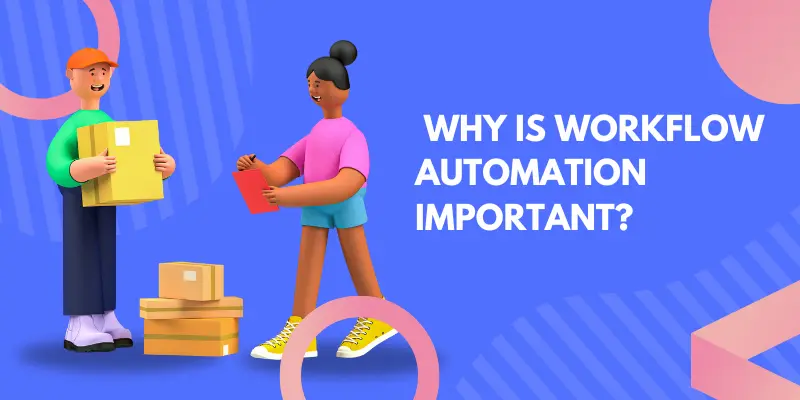Workflow Automation Examples: Complete Guide to Save Time & Boost Productivity
Published: 18 Apr 2025
Workflow automation examples are the process of using tools and software to handle repetitive tasks automatically. It’s like having a virtual assistant that takes care of the boring stuff, so you can focus on what truly matters.

Businesses and individuals alike can benefit from workflow automation—it saves time, reduces errors, and boosts productivity. In this guide, we’ll explore what workflow automation is, why it’s important, and real-life examples to help you get started.
What is Workflow Automation?
Before exploring the deeper details, it’s important to understand what workflow automation means. The image below gives a simple visual breakdown of the concept and its real-world use. With this visual in mind, let’s move into the details.

From defining the term to comparing manual and automated workflows, you’ll get a clearer picture of how it all works – along with the benefits of workflow automation, such as saving time, reducing errors, and improving team productivity.
A Simple Definition
Workflow automation is about using technology to complete tasks without manual effort. For example, instead of sending individual emails, you can set up a system to send them automatically.
How It Works in Everyday Tasks
Think of tasks like invoicing, scheduling, or data entry. Automation tools handle these for you, freeing up your time for more important work.
Manual vs. Automated Workflows
Manual: You spend hours sending invoices or updating spreadsheets.
Automated: Tools like QuickBooks or Zapier handle these tasks in seconds.
Why is Workflow Automation Important?
Workflow automation is a game-changer for businesses and individuals. Here’s why:

Saves Time: Automating repetitive tasks means you can focus on strategic work.
Reduces Errors: Machines don’t make mistakes like humans do.
Improves Efficiency: Teams can collaborate better when workflows are streamlined.
Helps Businesses Scale: Automation makes it easier to handle growth without adding more stress.
Real-Life Workflow Automation Examples
Real-life workflow automation examples show how businesses save time and reduce errors with smart tools. From automating invoices to streamlining customer support, the benefits are massive. These examples highlight how companies improve productivity without extra effort. With the right automation, you can focus on growth instead of repetitive tasks.
Marketing Automation
Automated Email Campaigns: Send personalized emails to new customers automatically.
Social Media Scheduling: Tools like Buffer or Hootsuite post content for you.
Lead Tracking: Automatically score and track potential customers.
Sales & CRM Automation
Lead Assignment: Auto-assign leads to sales reps based on criteria.
Follow-Up Reminders: Automatically remind reps to contact leads.
Invoice Generation: Create and send quotes or invoices without manual input.
HR & Recruitment Automation
Resume Screening: Use AI to filter resumes and find the best candidates.
Employee Onboarding: Automate welcome emails, training schedules, and document collection.
Payroll Processing: Tools like Gusto handle payroll without manual calculations.
Customer Support Automation
Chatbots: Handle FAQs and basic customer queries this year.
Ticket Routing: Automatically assign support tickets to the right team.
Feedback Surveys: Send surveys to customers after interactions.
Finance & Accounting Automation
Invoice Processing: Automatically read, approve, and pay invoices.
Expense Tracking: Use tools like Expensify to track receipts and expenses.
Financial Reporting: Generate reports automatically at the end of each month.
IT & Security Automation
Software Updates: Automatically update systems to the latest versions.
Cybersecurity Monitoring: Use AI to detect and respond to threats.
Access Control: Automatically grant or revoke employee access to systems.
How to Get Started with Workflow Automation
Step 1: Identify Time-Consuming Tasks
Look for tasks that take up too much of your time, like sending emails or tracking expenses.
Step 2: Choose the Right Tools
Pick tools that fit your needs. For example:
Zapier: Great for connecting apps and automating workflows.
HubSpot: Perfect for marketing and sales automation.
QuickBooks: Ideal for finance and accounting tasks.
Step 3: Test and Refine
Start small, test your workflows, and make adjustments as needed. Automation is a journey, not a one-time fix.
Conclusion
In the end, workflow automation examples prove that automation isn’t just about saving time—it’s about reducing errors, boosting efficiency, and creating space for growth. From marketing campaigns to customer support and financial tasks, businesses that embrace automation unlock smarter, smoother operations. Start small, scale gradually, and remember: workflow automation isn’t replacing humans, it’s empowering them to focus on what truly matters.
FAQs
Zapier is a great starting point because it’s easy to use and works with many apps.
Absolutely! Automation is perfect for small businesses to save time and grow efficiently.
Not always. Many tools offer free plans or trials, making them affordable for small teams.
Start with repetitive tasks like invoicing, email follow-ups, or data entry.
No, most tools are designed for beginners and come with step-by-step guides.
Over-automating too quickly can lead to errors.
Start small and test thoroughly.
No, automation is meant to assist, not replace. It handles repetitive tasks so humans can focus on creative work.
Consider your needs and budget. Look for tools with good reviews and free trials.
Pick one task, like sending follow-up emails, and automate it using a tool like Zapier.
Yes, by streamlining workflows, teams can collaborate more effectively and focus on high-value tasks.

- Be Respectful
- Stay Relevant
- Stay Positive
- True Feedback
- Encourage Discussion
- Avoid Spamming
- No Fake News
- Don't Copy-Paste
- No Personal Attacks

- Be Respectful
- Stay Relevant
- Stay Positive
- True Feedback
- Encourage Discussion
- Avoid Spamming
- No Fake News
- Don't Copy-Paste
- No Personal Attacks





